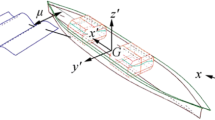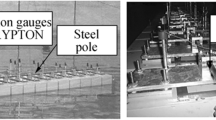Abstract
Nonlinear interactions among incident wave, tank-sloshing and floating body coupling motion are investigated. The fully nonlinear sloshing and body-surface nonlinear free surface hydrodynamics is simulated using a Non-Uniform Rational B-Spline (NURBS) higher-order panel method in time domain based on the potential theory. A robust and stable improved iterative procedure (Yan and Ma, 2007) for floating bodies is used for calculating the time derivative of velocity potential and floating body motion. An energy dissipation condition based on linear theory adopted by Huang (2011) is developed to consider flow viscosity effects of sloshing flow in nonlinear model. A two-dimensional tank model test was performed to identify its validity. The present nonlinear coupling sway motion results are subsequently compared with the corresponding Rognebakke and Faltinsen (2003)’s experimental results, showing fair agreement. Thus, the numerical approach presented in this paper is expected to be very efficient and realistic in evaluating the coupling effects of nonlinear sloshing and body motion.
Similar content being viewed by others
References
Beck RF, Cao Y, Scorpio SM, Schultz WW (1994). Nonlinear ship motion computations using the de-singularized method. 20th Symposium on Naval Hydrodynamics, Santa Barbara, CA, 1–20.
Contento G (1996). Nonlinear phenomena in the motions of unrestrained bodies in a Numerical Wave Tank. Proceeding of 6th International Offshore and Polar Engineering, ISOPE, Los Angeles, CA, 3, 18–22.
Duan WY (1995). Nonlinear hydrodynamic forces acting on a ship undergoing large amplitude motions. Ph.D. Thesis, Harbin engineering university. (in China)
Datta R, Sen, D (2007). The Simulation of ship motions using a B-Spline-based panel method in time domain. Journal of Ship Research, 51(3), 267–284.
Faltinsen OM, Timokha AN (2009). Sloshing. Cambridge University.
Huang S, Duan WY, Ma QW (2011). An approximation to energy dissipation in time domain simulation of sloshing waves based on linear potential theory. China Ocean Engineering, 25(2), 189–200.
Kashiwagi M, Momoda T, Inada M (1998). A time-domain nonlinear simulation method for waveinduced motions of a floating body. Journal of Society Navy Architect, 84, 143–152. (in Japanese)
Kim Y (2002). A numerical study on sloshing flows coupled with ship motion—The anti-rolling tank problem. Journal of Ship Research, 46(1), 52–62.
Kim Y, Nam BW, Kim DW, Kim YS (2007). Study on coupling effects of ship motion and sloshing. Ocean Engineering, 34, 2176–2187.
Kim Y, Shin YS, Lin WM, Yue DKP (2003). Study on sloshing problem coupled with ship motion in waves. 8th International Conference on Numerical Ship Hydrodynamics, Busan, Korea, September.
Koo W, Kim M (2004). Freely floating body simulation by a 2D fully nonlinear numerical wave tank, Ocean Engineering, 9, 2011–2046.
Malenica Š, Zalar M, Chen XB (2003). Dynamic coupling of seakeeping and sloshing. International Offshore and Polar Engineering, ISOPE, 3, May, 486–492.
Mitra S, Wang CZ, Reddy JN, Khoo BC (2012). 3D fully coupled analysis of nonlinear sloshing and ship motion. Ocean Engineering, 39, 1–13.
Molin B, Remy F, Rigaud S, de Jouette Ch (2002). LNG-FPSO’s: frequency domain coupled analysis of support and liquid cargo motions. Proceeding of INAM Conference, Rethymnon, Greece.
Rognebakke OF, Faltinsen OM (2003). Coupling of sloshing and ship motions. Journal of Ship Research, 47(3), 208–221.
Sen D (1993). Numerical simulation of motions of two-dimensional floating bodies. Journal of Ship Research, 37(4), 307–330.
Tanizawa K, Minami M (1998). On the accuracy of NWT for radiation and diffraction problem. Proceeding of 6th Symposium on Nonlinear and Free-surface Flow.
William GC (1971). Numerical Initial Value Problems in Ordinary Differential Equations. Prentice-Hall, Englewood Cliffs, NJ, 102–115.
Wu GX, Eatock Taylor R (1994). Finite element analysis of two dimensional non-linear transient water waves. Applying Ocean Research, 16, 363–372.
Wu GX (1998). Hydrodynamic force on a rigid body during impact with liquid, J. Fluid Structures, 12, 549–559.
Yan S, Ma QW (2007). Numerical simulation of fully nonlinear interaction between steep waves and 2D floating bodies using the QALE-FEM method. Journal of Computational physics, 221, 666–692.
Author information
Authors and Affiliations
Corresponding author
Additional information
Foundation item: Supported by the National Natural Science Foundation of China (Grant No. 51079032) and the “111 project” (Grant No. B07019).
Shuo Huang was born in 1984. She is a doctoral student at Harbin Engineering University. Her current research interests include hydrodynamic loads, tank sloshing and the prediction of seakeeping floating body motion.
Wenyang Duan was born in 1967. He is a professor and a PhD supervisor at Harbin Engineering University. His current research interests include nonlinear wave-body interactions, SPH method.
Hao Zhang was born in 1984.He is an engineer at CCCC-FHDI Engineering Co., Ltd (The Fourth Harbour Engineering Investigation and Design Institute of the Ministry of Communications, China Communication Construction Company). His current research interests include wave-body interactions and harbour design.
Rights and permissions
About this article
Cite this article
Huang, S., Duan, W. & Zhang, H. A coupled analysis of nonlinear sloshing and ship motion. J. Marine. Sci. Appl. 11, 427–436 (2012). https://doi.org/10.1007/s11804-012-1152-z
Received:
Published:
Issue Date:
DOI: https://doi.org/10.1007/s11804-012-1152-z




